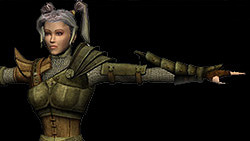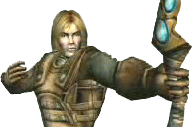|
News
Gallery
ScreenShots
ConceptArt
Models
Wallpapers
Movies
Articles
Lore & History
Teasers
From the Dev
Newsletters
Links
|
|
The
Turbine 2 Engine
Technical foundation
After completing the successful launch of Asheron's Call,
the core engine team at Turbine set out to create a next generation engine
for MMORPGs (massively multiplayer online role-playing games). Although
no deal had yet been signed for a sequel, it was very much on the minds
of the team when building the foundation of the engine. The Turbine 2 Engine
would have to be capable of creating worlds massive in scale, seamless in
layout, and utterly compelling in graphical presentation.
Having spent over three years developing the original Asheron's Call,
the team put solutions that would speed up the game development process
high on the list. For that, a byte-compiled scripting language was written
to handle gameplay functions. With such a language, developers no longer
need to recompile the entire server every time they wish to make a change
to gameplay. Instead, changes can be separately compiled as smaller chunks
and then added to the larger code. This process allows game designers to
simply write gameplay scripts instead of needing to understand all of the
server code or to work in C++. For AC2, the potential is now there
to add new features, such as skills and quest dynamics, at the same level
as adding new content.
Graphic results
After two years of work, the engine's graphic systems have been completely
rewritten. In game design, the typical approach is to allow engine graphics
to scale down, taking into consideration the capacity of low-end machines.
However, as massively multiplayer games have a far longer lifespan than
the conventional game, the Turbine 2 Engine was designed to account for
the future by ensuring its systems could scale up as well as down. GeForce3
and ATI Radion cards represent the current edge of graphics cards today,
but newer cards and faster CPUs are right around the corner. The Turbine
2 Engine needed to meet both current and future expectations in a variety
of its graphic systems and effects, thus introducing the concept of upward
scalability to the PC.
The appearance system

|
|
The “appearance system” controls the visible and auditory
representation of every object, and allows Turbine developers infinite
control over every model in the game. Characters, which range from
2,000 to 5,000 polygons apiece, can swap out sections of their models
while still remaining seamless, allowing a wide range of facial features,
hairstyles, armors and clothing styles, as well as new options such
as height and build. When characters put on metal boots, you'll hear
the slight clanking as they walk. When they're hit with a blow to
their armor, you'll hear the sound of the metal instead of their flesh.
|
 The shading system
The shading system

|
|
While past games relied on simple textures painted onto objects to
provide their color and shading, AC2 boasts far more dynamic
tools. The engine runs a scriptable shading language and supports
pixel and vertex shaders, providing artists with an easy-to-use system
to describe the surface of an object. These shaders work in conjunction
with the appearance system, allowing your characters to get covered
in blood or the dents in their armor to properly reflect the light
and environment around them. |
Blended animation
Whereas in AC1 animations were limited to playback of a single motion,
the current engine allows multiple animations to be blended together for
more complex motions. At a rudimentary level, a character may tap his foot
while waving, then proceed to walk while continuing to wave. At a more complex
level, characters may appear winded when low in vigor. Such visual clues
allow players to break free of watching chat spew to see their characters'
state.
Environment and weather

|
|
Beyond the characters, new graphic systems have been implemented within
the world at large. The water reflects the environment and characters
around it. Clouds change shape as they roll across the sky. The smoke
from a campfire and the grass and trees that fill the world all sway
in the breeze.
Many of the games recently released have had to make difficult decisions
in regards to shadows, choosing either bitmaps for per-pixel lighting
with hard stencil shadows, or soft shadows without bitmaps. In AC2,
soft shadows exist at all times, in conjunction with bitmaps. Shadows
and lighting can also be dynamic, with a torch lighting up a dungeon
hall, or a gate casting eerie shadows as it opens. On the surface,
the clouds and trees cast shadows on the ground below. The characters
themselves cast volume-metric shadows, allowing their shadows to creep
along walls. |
Other visual effects include heat distortion, seen in such games as Devil
May Cry and Extreme G on the PlayStation
2. The Turbine 2 Engine brings these effects, once specific to console games,
to the PC. The heat from torches can distort the area behind them, while
a spell effect warps the walls of a corridor it's fired down. The engine
also supports motion-blur effects, in the realm of SSX on the PS2.
To meet the needs of AC2, it takes a game engine of no small skill.
The preceding just begins to describe what graphic elements you'll see in
the game, but many more areas await discussion: the far view system, the
lighting in dungeons, the coordinated use of visuals and sound. Future behind-the-scenes
articles will cover these finer points and highlight some of the Turbine
developers who've created these systems and pushed them to their limits
for Asheron's Call 2.
|



 The shading system
The shading system